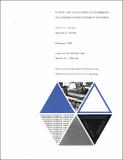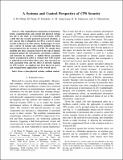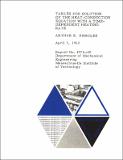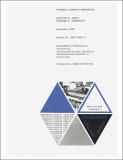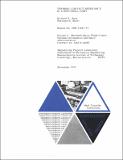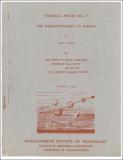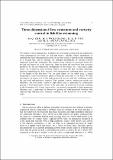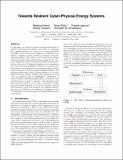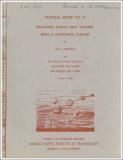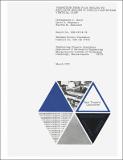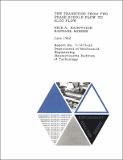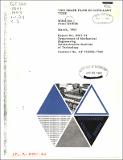Browsing Department of Mechanical Engineering by Title
Now showing items 112-131 of 137
-
Survey and Applications of the 1D Finite Element Method
(2021-01-20) -
Survey and evaluation of techniques to augment convective heat transfer
(Cambridge, Mass. : M.I.T. Dept. of Mechanical Engineering, [1965], 1965)This report presents a survey and evaluation of the numerous techniques which have been shown to augment convective heat transfer. These techniques are: surface promoters, including roughness and treatment; displaced ... -
A Systems and Control Perspective of CPS Security
(2019-01-22)Abstract—The comprehensive integration of instrumentation, communication, and control into physical systems has led to the study of Cyber-Physical Systems (CPS), a field that has recently garnered increased attention. ... -
Tables for solution of the heat-conduction equation with a time-dependent heating rate
(Cambridge, Mass. : M.I.T. Heat Transfer Laboratory, [1962], 1962)Tables are presented for the solution of the transient onedimensional heat flow in a solid body of constant material properties with the heating rate at one boundary dependent on time. These tables allow convenient and ... -
Theoretical Estimates of Mechanical Properties of the Endothelial Cell Cytoskeleton
(Biophysical Society, 1996)Current modeling of endothelial cell mechanics does not account for the network of F-actin that permeates the cytoplasm. This network, the distributed cytoplasmic structural actin (DCSA), extends from apical to basal ... -
Thermal boundary layer development in dispersed flow film boiling
(Cambridge, Mass. : Heat Transfer Laboratory, Dept. of Mechanical Engineering, Massachusetts Istitute of Technology, [1982], 1982)Dispersed flow film boiling consists of a dispersion of droplets which are carried over a very hot surface by their vapor. This process occurs in cryogenic equipment and wet steam turbines. It is also of interest in the ... -
Thermal contact conductance in a vacuum
(Cambridge, Mass. : M.I.T. Engineering Projects Laboratory, [1965], 1965)The object of this work is to develop analytically equations by which one could predict the thermal contact conductance between contiguous surfaces operating in a vacuum environment. In this work the solution to the problem ... -
Thermal contact resistance
(Cambridge, Mass. : M.I.T. Dept. of Mechanical Engineering, [1966], 1966)This work deals with phenomena of thermal resistance for metallic surfaces in contact. The main concern of the work is to develop reliable and practical methods for prediction of the thermal contact resistance for various ... -
Thermal contact resistance in a non-ideal joint
(Cambridge, Mass. : M.I.T. Dept. of Mechanical Engineering, [1971], 1971)The contact conductance at an interface can be determined by knowing the material and surface properties and the interfacial pressure distribution. This pressure distribution can be influenced strongly by the roughness of ... -
Thermal contact resistance with non-uniform interface pressures
(Cambridge, Mass. : M.I.T. Engineering Projects Laboratory, [1970], 1970)This work considers the effect of roughness and waviness on interfacial pressure distributions and interfacial contact resistance. It is shown that for moderate roughness the contour area could be substantially different ... -
Thermal non-equilibrium in dispersed flow film boiling in a vertical tube
(Cambridge, Mass. : M.I.T. Dept. of Mechanical Engineering, [1966], 1966)The departure from thermal equilibrium between a dispersed liquid phase and its vapor at high quality during film boiling is investigated, The departure from equilibruim is manifested by the high resistance to heat transfer ... -
The thermodynamics of bubbles
(Cambridge, Mass. : Massachusetts Institute of Technology, Division of Industrial Cooperation, [1956], 1956)This paper outlines those concitions annanded by the laws of thermodynamics for equilibriza betwoen the vapor in a bubble and the surrounding liquid and then employs these concepts with a nucleation theory in an atteapt ... -
Three-dimensional flow structures and vorticity control in fish-like swimming
(Cambridge University Press, 2002)We employ a three-dimensional, nonlinear inviscid numerical method, in conjunction with experimental data from live fish and from a fish-like robotic mechanism, to establish the three-dimensional features of the flow ... -
Towards Resilient Cyber-Physical Energy Systems
(2017-03-14)In this paper, we develop a system-of-systems framework to address cyber-physical resilience, the ability to withstand the combined presence of both cyber attacks and physi-cal faults. This framework incorporates a definition ... -
Transition boiling heat transfer from a horizontal surface
(Cambridge, Mass. : Massachusetts Institute of Technology, Division of Industrial Cooperation, [1960], 1960)An experiment, utilising a condensing fluid as the heat source, was performed to determine the heat flux vs. temperature difference curve for transition pool boiling from a horisontal surface. The boiling cure was determined ... -
Transition from film boiling to nucleate boiling in forced convection vertical flow
(Cambridge, Mass. : M.I.T. Heat Transfer Laboratory, [1972], 1972)The mechanism of collapse of forced cnnvection annular vertical flow film boiling, with liquid core, is investigated using liquid nitrogen at low pressures. The report includes the effect of heat flux from the buss bar. ... -
The transition from the annular to the slug flow regime in two-phase flow
(Cambridge, Mass. : M.I.T. Division of Sponsored Research, [1964], 1964)Experiments were conducted to determine the transition from annular to semiannular flow regimes for two-phase, gas-liquid upflow in vertical tubes. The influencesof liquid flow rate, tube diameter, liquid viscosity, surface ... -
The transition from two phase bubble flow to slug flow
(Cambridge, Mass. : M.I.T. Division of Sponsored Research, [1962], 1962)The process of transition from bubble to slug flow in a vertical pipe has been studied analytically and experimentally. An equation is presented which gives the agglomeration time as a function of void fraction, channel ... -
Turbulent Flow over a Flexible Wall Undergoing a Streamwise Traveling Wavy Motion
(Cambridge University Press, 2003)Direct numerical simulation is used to study the turbulent flow over a smooth wavy wall undergoing transverse motion in the form of a streamwise travelling wave. The Reynolds number based on the mean velocity U of the ... -
Two phase flow in capillary tubes
(Cambridge, Mass. : M.I.T. Heat Transfer Laboratory, [1963], 1963)The flow of two phases, gas and liquid, has been studied in horizontal tubes of capillary diameter. The flow has been primarily studied in the regime where the gas flows as long bubbles separated from the wall of the tube ...


